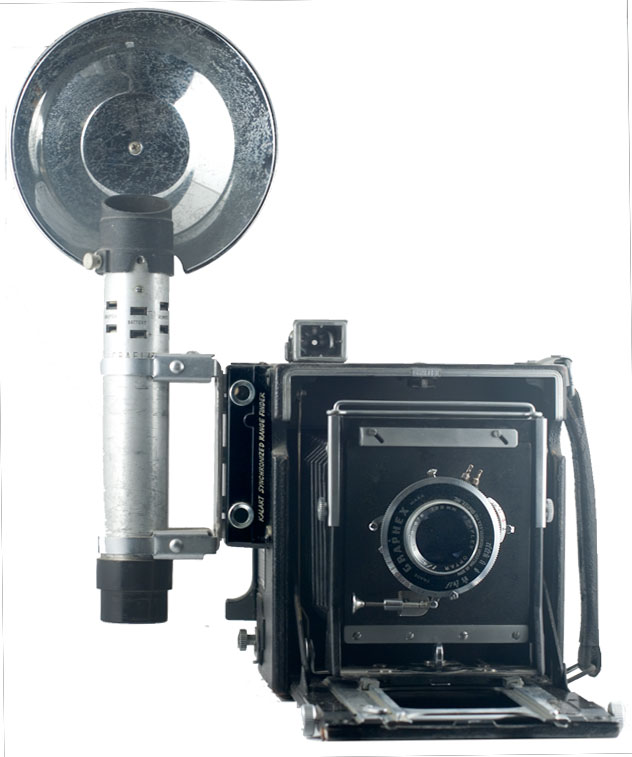
Approx. dates of manufacture: 1912 - 1973 (all versions), Anniversary Edition: 1940 - 1946
Approx. original price: $114.30 (1940)
Approx. street value: $100
William Folmer was a bicyle maker when he got interested in photography; and being an inventor, he saw ways to make improvements. Through most of the 19th century, light-sensitive materials (which I'll call film for simplicity here) were not very light sensitive, so exposures were measured in seconds and minutes, and could be done by simply taking the lens cap off for the required time and then putting it back on. But as film became more sensitive, photographers needed a way of making faster exposures. Folmer's idea was a mechanically moving curtain that was located right next to the film in the back of the camera, and it became known as the focal-plane shutter. Many of the best film cameras still use focal-plane shutter.
The Graflex was the company's marquee brand, but it was the Graphic that really endured. A Graphic a field camera, which means it's a portable (or luggable) view camera: the image is focused on a ground glass in the rear of the camera, or by using a viewfinder attached to the side. It collapses into a sturdy but light box. This made it very popular with newspaper photographers of the time; it was very versatile but it was also light and hand-holdable and it could take a beating. It was so common among photojournalists that it became known as a press camera. If you've seen old movies, or movies set between the 30s and the 50s, chances are you see newspaper photographers using these cameras.
There are a lot of different Graphics around. Graflex had two major types: the Speed Graphic had a focal plane shutter and was very fast; the Crown Graphic relied on a leaf shutter in the lens.
Speed Graphics are further subdivided into editions. The original edition, made between 1912 and 1928, is typically just called a Speed Graphic. The updated model, between 1928 and 1939, is typically called a pre-anniversary edition (the contract killer in the movie Road to Perdition used this camera). From 1940 to 1946 they made the Anniversary Edition, celebrating their 50 years in business. In 1947 they brought out their Pacemaker edition, which is their ubiquitous model, and the one you are likely to see in movies or tv. They made that until 1973 when the company folded. They also made Century Speed Graphics and Super Speed Graphics.
Mine is an Anniversary Edition, and I believe it's from 1945 or 1946 because of the nameplate. The company changed its name several times over the years, and it only became Graflex, Inc. in 1945, and it ended production of the Anniversary in 1946. If my nameplate said Folmer Graflex, I would date it prior to 1945.
This one came from a garage sale, and I got it and a cheap view camera for $75 and $50 respectively. Mine has the Kalart rangefinger and an Optar 135mm lens in a Graftar shutter, which is decent but not spectacular glass. But the nice thing about this camera is that I could hunt down better lenses and mount them; the camera was built to take a range of different lenses. The flash handle I had to get from eBay (and I'd like to take this time to make an obscene gesture to the Star Wars geeks (and especially George Lucas, who started it) who buy these things to make light-saber handles out of them.)
Camera manual: Orphan Cameras.com


